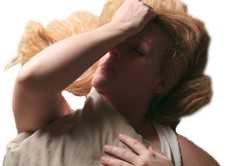3.11 Dependence and withdrawal
 Although antipsychotics do not cause psychological dependence, physical dependence can result in withdrawal effects especially on abrupt discontinuation of the antipsychotic after prolonged use. Symptoms of acute withdrawal include nausea, vomiting, anorexia, sweating, muscle pain, paraesthesia1, insomnia, restlessness, and anxiety; movement disorders such as akathisia2, dystonia3 and dyskinesia4 may also occur. Also, psychotic symptoms may recur on abrupt withdrawal.
Although antipsychotics do not cause psychological dependence, physical dependence can result in withdrawal effects especially on abrupt discontinuation of the antipsychotic after prolonged use. Symptoms of acute withdrawal include nausea, vomiting, anorexia, sweating, muscle pain, paraesthesia1, insomnia, restlessness, and anxiety; movement disorders such as akathisia2, dystonia3 and dyskinesia4 may also occur. Also, psychotic symptoms may recur on abrupt withdrawal.
Abrupt withdrawal of antipsychotics with significant antimuscarinic (anticholinergic)5 properties may precipitate excessive sweating, headache, and diarrhoea.
Withdrawal symptoms usually begin within four days of discontinuing the antipsychotic and may take one to two weeks to subside.
Factors which increase risk
Length of antipsychotic treatment, dose, and the speed of cessation are likely factors contributing to the risk of withdrawal reactions. Simultaneous discontinuation of antimuscarinic and antipsychotic medicines appears to increase the intensity of antipsychotic withdrawal effects.
Risk-reduction measures
Recurrence of psychotic symptoms may occur and features of a relapse should be distinguished from withdrawal effects. If withdrawal effects occur, a careful history of the symptoms should be taken, paying attention to the temporal relationship with reduction or cessation of drug dosage.
Withdrawal of an antipsychotic after long-term therapy should be gradual and closely monitored to avoid the risk of acute withdrawal syndromes or relapse. Patients should be advised about the potential for withdrawal symptoms.
If an antipsychotic and an antimuscarinic are being taken together, it may be best to taper and stop the antipsychotic first, and then taper and stop the antimuscarinic separately.
Treatment
Most withdrawal effects are relatively mild and resolve spontaneously and the patient should receive support, education and reassurance. Symptomatic treatment may also be considered (ie short-term use of benzodiazepines for anxiety symptoms or sleep disturbance; or use of antimuscarinic drugs for cholinergic symptoms). If withdrawal effects do not resolve or are severe, the antipsychotic may need to be reinstituted, with a view to a slower tapering of dose. Specialist advice may be required in difficult cases.
Patients should be monitored for two years after withdrawal of the antipsychotic for signs and symptoms of relapse of psychosis6.
This learning module discusses noteworthy risks for antipsychotics. Summaries of product characteristics and the BNF should be consulted for a fuller account of the adverse effects and warnings for individual antipsychotics.
- Sensation of numbness or tingling in the skin, popularly known as ‘pins and needles’↩
- Sensation of restlessness and a compulsion to move constantly↩
- A neurologically based movement disorder involving sustained contraction of the affected muscles, leading to abnormal posturing or repetitive movements or both↩
- A neurologically based movement disorder involving involuntary movement such as tremors and writhing and diminished ability to initiate voluntary movement↩
- Reduction or blocking of the effects of parasympathetic nerves; antimuscarinic effects include dry mouth, difficulty swallowing, blurred vision, confusion, palpitations, constipation, and urine retention↩
- Symptoms involving loss of contact with reality, including hallucinations (affecting hearing, smell, feel or sight), delusions, paranoia, and thought disorders; the individual may appear unusually withdrawn or excited. The components of psychosis are often described as ‘positive’ symptoms (such as hallucinations and delusions), ‘negative’ symptoms (such as apathy and withdrawal) and ‘cognitive symptoms’ (such as difficulties performing complex tasks). Psychoses can result from brain injury (eg through trauma, stroke, tumours, and infection), or the use of (usually illicit) drugs, or as a result of psychiatric disorders such as schizophrenia and severe mood disorders↩